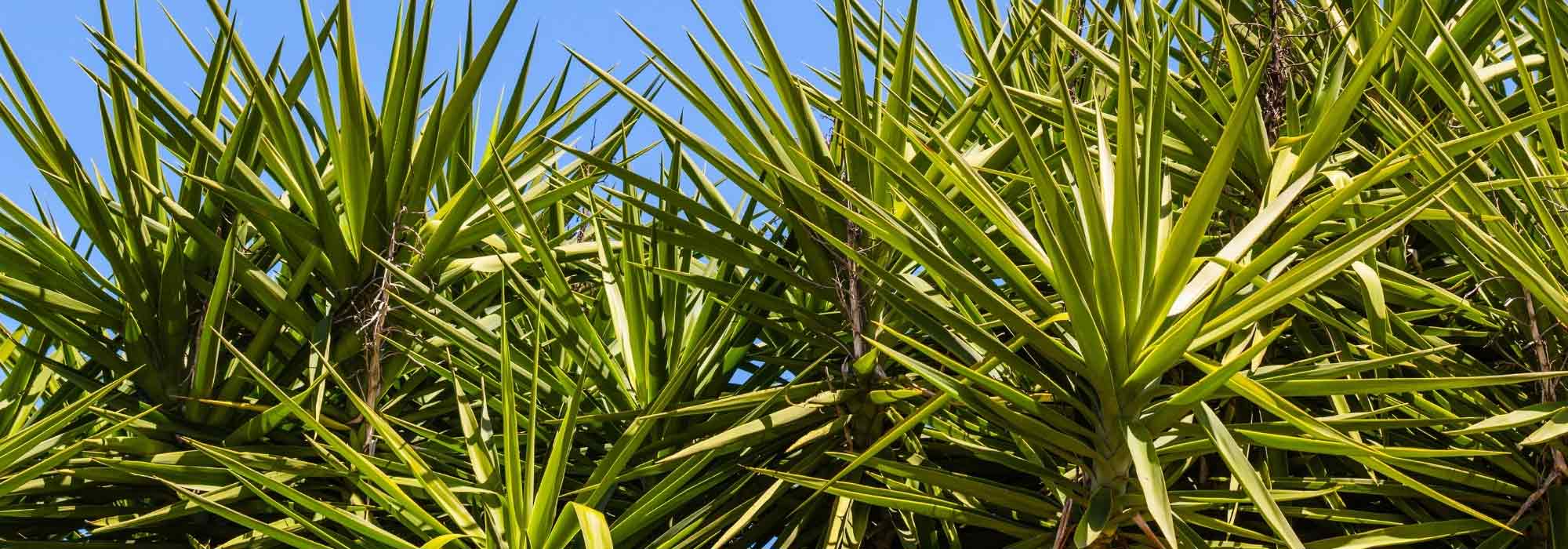
Diseases and Pests of Yucca
Detecting and treating them naturally
Contents
Naturally resistant and not very susceptible to diseases and pests, Yuccas can still fall victim to certain attacks that compromise their beauty for some, and can be deadly for others. Is your Yucca showing signs of weakness, and do you suspect small pests or diseases to be responsible? Don’t panic: here we list the main sources of attacks on Yuccas and how to remedy them.
→ To become an expert in Yucca cultivation, feel free to consult our complete guide: OUTDOOR YUCCA: CHOICE, PLANTING, MAINTENANCE, IN POT OR IN GARDEN
My Yucca is sick. What’s wrong with it? What should I do?
“`css
/* Style for the summary table */
.tableau-resume-yucca {
width: 100%;
border-collapse: collapse;
margin: 20px 0;
font-size: 16px;
font-family: Arial, sans-serif;
box-shadow: 0 2px 8px rgba(0,0,0,0.1);
overflow-x: auto;
display: block;
}
.tableau-resume-yucca th {
background-color: #e6f4ea;
color: #2d5a27;
text-align: left;
padding: 12px;
border-bottom: 2px solid #c1dec5;
}
.tableau-resume-yucca td {
padding: 12px;
border-bottom: 1px solid #ddd;
vertical-align: top;
}
.tableau-resume-yucca tr:nth-child(even) {
background-color: #f9fdf9;
}
.tableau-resume-yucca tr:hover {
background-color: #f1f9f2;
}
/* Responsive for mobile */
@media (max-width: 768px) {
.tableau-resume-yucca thead {
display: none;
}
.tableau-resume-yucca tr {
display: block;
margin-bottom: 15px;
border: 1px solid #ddd;
border-radius: 8px;
padding: 10px;
background-color: #fff;
}
.tableau-resume-yucca td {
display: block;
text-align: left;
padding: 8px 10px;
border: none;
position: relative;
}
.tableau-resume-yucca td:before {
content: attr(data-label);
font-weight: bold;
color: #2d5a27;
display: block;
margin-bottom: 5px;
}
}
“`
| Observed Symptoms | Probable Cause | Natural Solutions |
|---|---|---|
| Browning and wilting of leaves at the base | Yucca weevil | Remove affected leaves Monitor for adults Set up pheromone traps |
| Curled leaves, sticky honeydew, and black sooty mould | Aphids | Encourage beneficial insects (ladybirds) Install insect hotels Diversify vegetation |
| Presence of fine webs, discoloured leaves | Spider mites / Red spiders | Shower foliage in warm weather Introduce Phytoseiulus persimilis Create shelters for lacewings |
| Cottony white spots, weakened leaves | Mealybugs | Encourage biodiversity Use paraffin oil or black soap Avoid chemical insecticides |
| Brown or black concentric spots on leaves | Yucca phoma (fungus) | Spray a horsetail decoction in spring Remove and dispose of affected leaves Treat with Bordeaux mixture |
| Wilted leaves, plant declining | Root rot (excess moisture) | Improve drainage (gravel, pumice) Space out watering Avoid standing water under the pot |
“`
Read also
Choosing a yuccaA browning at the base of Yucca leaves: the Yucca weevil
Symptoms and Cause
The weevil is the most challenging pest of the Yucca genus to manage. Also known as the agave weevil, Scyphophorus acupunctatus is a beetle native to Mexico that was introduced to Europe with infested plants. Since the early 2000s, damage has been increasingly significant in France on Agaves, Dracaenas, Yuccas, and Dasylirions.
This pest is a small black beetle measuring 10 to 15 mm in length. It is identifiable by its long incurved rostrum. It primarily manifests when temperatures are high and the climate is dry, which is why it is notably found on the Côte d’Azur and the Mediterranean coast. In a single year, several generations can emerge. The female lays her eggs in the leaves of the plant (especially in agaves) or in its stem depending on the species. The larvae migrate to the base of the plant, burrowing galleries in the fleshy parts. As the affected plants are eaten from the inside, bacterial and fungal attacks accelerate their decline.
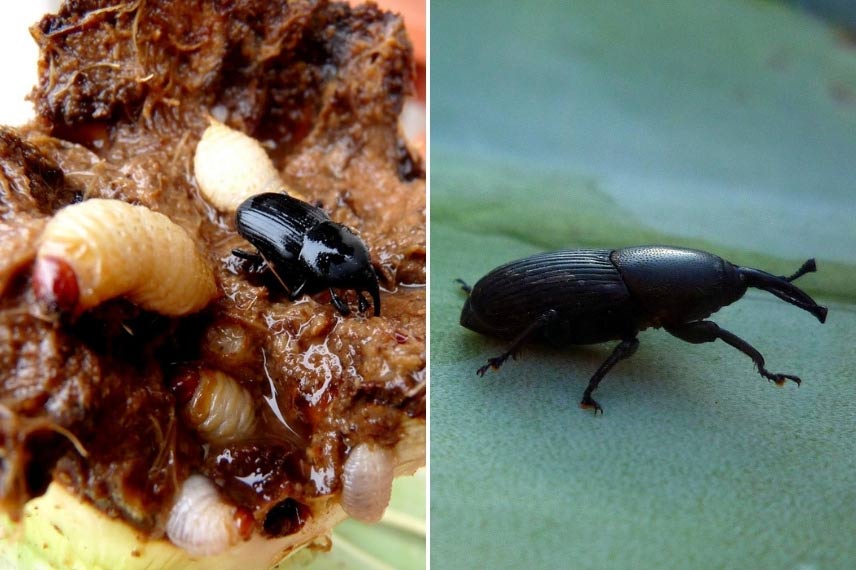
The Yucca Weevil (By Nanosanchez — Own work, CC BY-Wikipedia)
Treatment
The best approach is to act preventively and ensure your yuccas remain as healthy as possible.
- When perforation holes, signs of rotting, or galleries appear on the leaves, systematically remove those that are affected
- Carefully observe the area for adults
- Install pheromone traps to catch males and limit proliferation
Discover other Yucca
View all →Available in 1 sizes
Available in 3 sizes
Available in 1 sizes
Available in 2 sizes
Available in 1 sizes
Available in 2 sizes
Available in 1 sizes
Available in 1 sizes
Available in 1 sizes
Available in 1 sizes
Yucca leaves are curling: aphids
Symptoms and Cause
Grouped on young shoots in colonies, aphids suck the sap from plants to feed. The shoots and leaves of affected Yuccas curl up and honeydew flows out, on which sooty mould forms. No plant is spared from aphids, and even though their attacks are spectacular, they are generally not significantly affected. Nevertheless, aphids transmit viruses to them, hence the need for regulation.
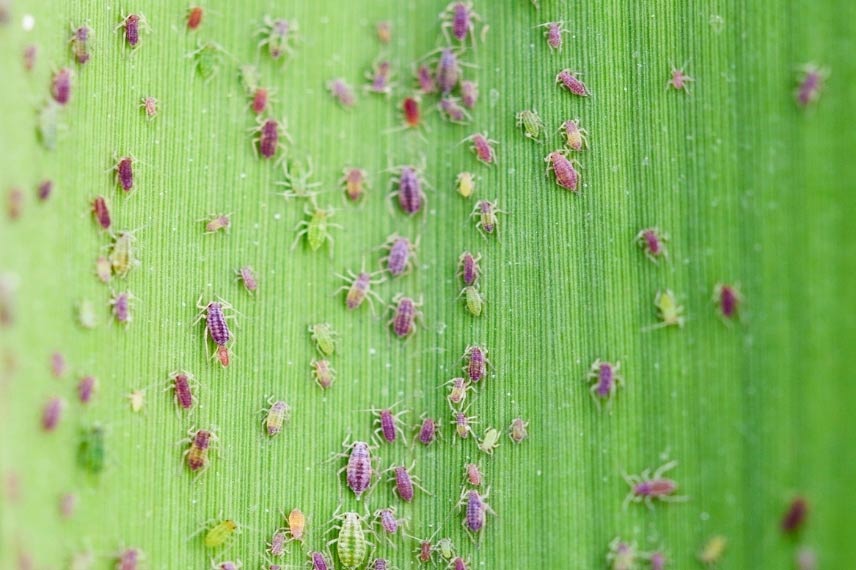
Aphids
Treatment
Encouraging the development of beneficial insects can greatly resolve the aphid problem on your Yuccas as well as on other plants. Diverse and free hedges, differentiated mowing, insect hotels, and piles of leaves and wood: simple actions can allow you to garden without tiring yourself and let nature play its regulatory role. Ladybird larvae are also available for you to reintroduce at home and limit the spread of aphids.
→ To learn more about treating aphids, check our dedicated sheet: “Aphid: identification and treatment. Our tips for natural and effective control.”
Read also
The most beautiful yuccasYour Yucca is covered in a kind of spider web: spider mites or red spiders.
Symptoms and Cause
The term “red spider” actually refers to mites, sometimes red in colour, that absorb the contents of the foliar cells of plants. Yuccas can suffer from these infestations when conditions are right, particularly heat and sunlight. Excessive fertilisation also promotes their proliferation by making plants very attractive to these “red spiders”: nitrogenous fertilisers soften the foliar tissues, while potash increases sugar secretion.

Mites or red spiders.
Treatment
- Mites hate humidity: shower the foliage of your yuccas in the evening during hot weather to prevent attacks that are particularly severe when the weather is hot and dry.
- Release beneficial insects such as the mite Phytoseiulus persimilis, which is a specific and formidable predator of the red spider.
- Place one or more insect hotels or piles of dead branches near your sensitive plants to provide a home for lacewing larvae, natural predators of this pest.
→ To learn more about treating red spiders, check out our dedicated sheet: “Red Spider: Identification and Treatment – Recognising and Effectively Combating Them”.
White cottony masses on your Yucca: mealybugs
Symptoms and Cause
Often found in gardens, mealybugs attack a wide variety of plants. These pests are part of the piercing-sucking insects, just like aphids. Easily spotted on yucca, they rarely kill it, but can significantly weaken it. They infest the stems and leaves, with a preference for young, tender shoots.
Through their actions, mealybugs can also transmit viruses by producing honeydew, a sticky and sweet substance. This honeydew leads to the appearance of sooty mould, a black fungus, on the leaves and branches of yuccas.
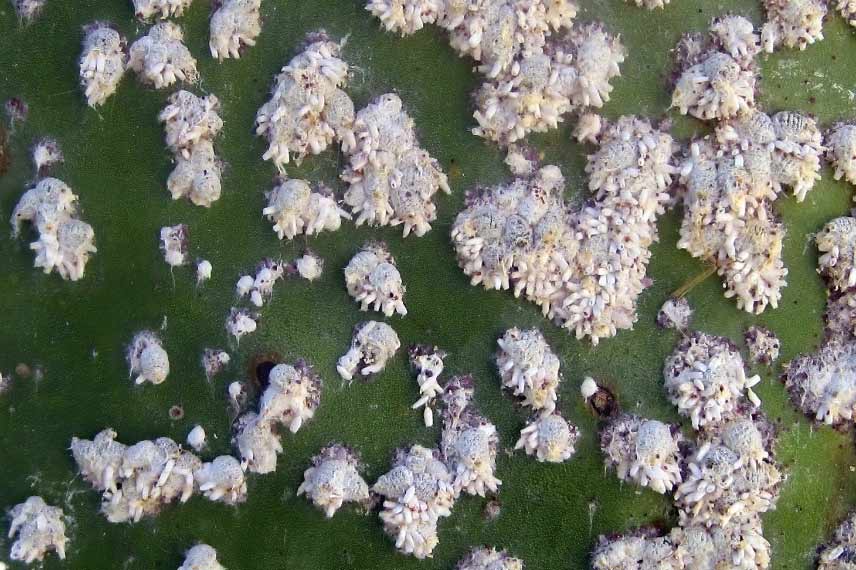
Mealybugs
Treatment
- Encouraging biodiversity in the garden helps to prevent the appearance of mealybugs. Natural enemies of these pests, such as ladybird larvae, will help regulate them. They can also be purchased for biological control.
- On infested yuccas, one can use a treatment based on paraffin oil or remove the larvae using black soap.
- Insecticides should be avoided: in trying to destroy the mealybugs on your yuccas, you will also eliminate beneficial insects, which are essential for maintaining a biological balance.
→ To learn more about treating mealybugs, check our dedicated sheet: “Mealybug: identification and treatment. Our tips for natural and effective control”
Brown or black circular spots on Yucca leaves: Yucca Phoma or concentric spot disease
Symptoms and Cause
Are the leaves of your Yucca showing concentric brown or black spots? This is a specific cryptogamic disease common in yuccas, caused by a fungus: Phoma or Coniothyrium, which is quite difficult to combat once established. It thrives in moisture and cold and becomes apparent as temperatures warm up in spring. Pruning wounds provide an entry point for this cryptogamic disease: when maintaining your Yuccas, be sure to cut off naturally drying leaves with pruning shears or scissors rather than pulling them off.
 Telltale spots of Phoma on Yucca
Telltale spots of Phoma on Yucca
Treatment
- At the beginning of spring, spray preventively with a horsetail decoction
- If your yucca shows symptoms of Phoma, remove the affected leaves and then treat your plant with Bordeaux mixture
- Yuccas generally resist this fungus, although they may lose leaves to some extent due to its attack. Remove the most affected leaves and dispose of them to help the plant.
Your Yucca is wilting: root rot
Symptoms and Cause
Your Yuccas can also suffer from root rot, caused by excessive moisture. This rot generally affects yuccas planted in poorly drained soils or when overwatered. The leaves wilt, and then the entire plant declines.
Treatment
Radically reduce water supply to the yuccas. Also provide them with better-drained soil:
- Add gravel or pumice when planting in the ground, and don’t hesitate to place your yuccas on a small mound if your soil is clayey to encourage drainage away from their base. Position your yuccas in sunny locations to avoid stagnant moisture from shaded areas.
- Add clay balls or terracotta shards when planting in pots. Space out waterings and allow the substrate to dry between applications. Finally, avoid placing a saucer where water could stagnate under the pot.
→ To learn everything about drainage, check out Virginie’s article: Turf, sand, perlite, vermiculite, clay balls, pumice… WHAT FOR?
- Subscribe!
- Contents

































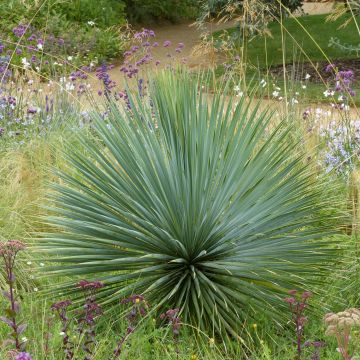

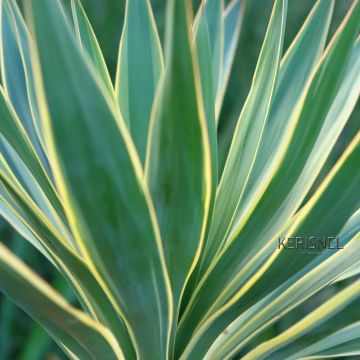

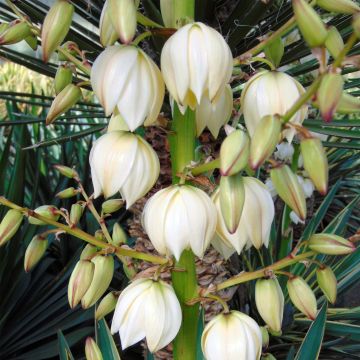



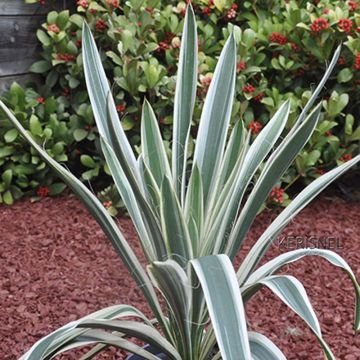
Comments